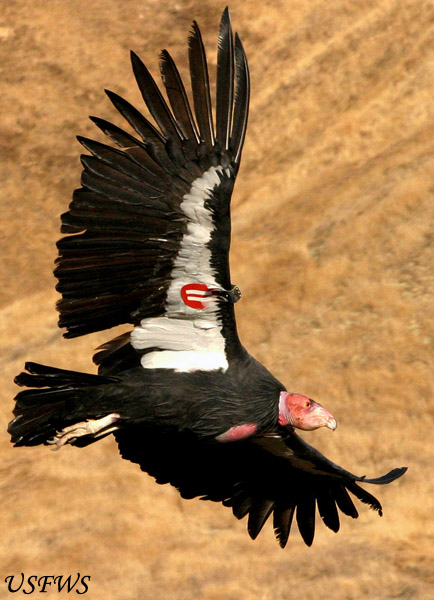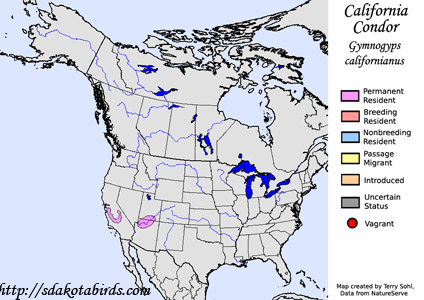California Condor
Gymnogyps californianus
| Length: 46 inches | Wingspan: 110 inches | Seasonality: Non-resident in South Dakota |
| ID Keys: Immense size, dark overall, pinkish head and neck, white patch on underside of wings | ||
 The
California Condor is one of the largest, and rarest, of North American
Birds. Numbers of California Condors began declining after settlement
of the West began in the 1800s. By 1987, only 22 birds were left, and
all 22 birds were captured and brought into captivity in hope to breed and
increase the population. Captive-bred birds began to be released into
the wild in 1991, with releases continuing to this day. As of 2012,
there were approximately 400 California Condors, with about half in
captivity and half in the wild.
The
California Condor is one of the largest, and rarest, of North American
Birds. Numbers of California Condors began declining after settlement
of the West began in the 1800s. By 1987, only 22 birds were left, and
all 22 birds were captured and brought into captivity in hope to breed and
increase the population. Captive-bred birds began to be released into
the wild in 1991, with releases continuing to this day. As of 2012,
there were approximately 400 California Condors, with about half in
captivity and half in the wild.
The original causes of the decline of the species were many and varied. Poaching and shooting of the birds undoubtedly caused some of the initial decline. Ranchers in the West saw the massive birds feeding on dead cattle, and often assumed the Condors themselves were responsible for the death of livestock. They were thus persecuted for their supposed potential negative impacts on lifestock operations. A significant cause of mortality has also been the ingestion of lead ammunition from dead animals. Animals killed with lead pellets or bullets are preyed upon by California Condors, and the unusually strong and effective digestive system of the species results in the intake of large amounts of lead. Lead poisoning has undoubtedly led to the death of many California Condors over the last century, and continues to be an issue for the small remaining wild population.
Releases of captive bred birds continues, with releases in Arizona (near the Grand Canyon) and central California. Captive bred California Condors have bred and successfully raised young in the wild, but breeding success in the wild remains frustratingly low, and the small wild population is still primarily maintained through the release of captive-bred birds.
Habitat: California Condors were once found in much of the Western United States. In general, they are found in areas with large open habitats with foraging opportunities, but with cliffs or large trees nearby for nesting.
Diet: Feeds on carrion. Historically, prior to settlement of the West, they fed on the carcasses of large animals, with food items dependent upon location and availability. Inland, large animal carcasses such as deer, elk, bears, or other large animals are consumed, although smaller animals down to the size of rabbits are also consumed. In coastal areas, Condor populations often specialized on aquatic mammal carcasses, with whale or seal carcasses often providing a source of food.
Behavior: California Condors lack a sense of smell and hunt by sight. Carrion is spotted by soaring and looking for carcasses. Foraging is usually done during the warmer parts of the day, when rising thermals aid the flight of the large birds.
Nesting: The California Condor usually builds a nest in a cave or protected shelf on a cliff face. They also historically used very large cavities in large trees, such as the top of a broken-off large evergreen tree. The nest itself is typically only a loose collections of a few stones and pebbles. Both the males and females incubate the eggs, with incubation last nearly 2 months. Upon hatching, both parents will forage for food and feed the young. Given the long incubation period and the relatively long period of time before the young leave the care of their parents, California Condors are only able to nest every other year. The very slow rate of reproduction has frustrated efforts to quickly raise wild populations of the species.
Song: California Condors are generally silent. The only noises produced are occasional hissing and grunting sounds.
Migration: Considered a permanent resident throughout their range, but individual birds sometimes do move fairly long distances in search of foraging opportunities.
Interactive eBird Map: Click to access an interactive eBird map of California Condor sightings
Similar Species: Unlikely to be mistaken for another species.
Conservation Status: The IUCN currently lists the California Condor as critical endangered. They remain one of the rarest birds in the world, with only a few hundred alive, with about half in captivity and half in the wild.
Further Information: 1) U.S. Fish and Wildlife - California Condor Species Profile
2) Cornell's All About Birds - California Condor
3) National Geographic - California Condor
Photo Information: October 18th, 2003 - Bitter Creek National Wildlife Refuge - U.S. Fish and Wildlife Service photo - Photo licensed through Creative Commons 2.0 Generic license.
| Click below for a higher-resolution map |
 |
| South Dakota Status: Non-resident in South Dakota |
Additional California Condor Photos (coming soon!!)
